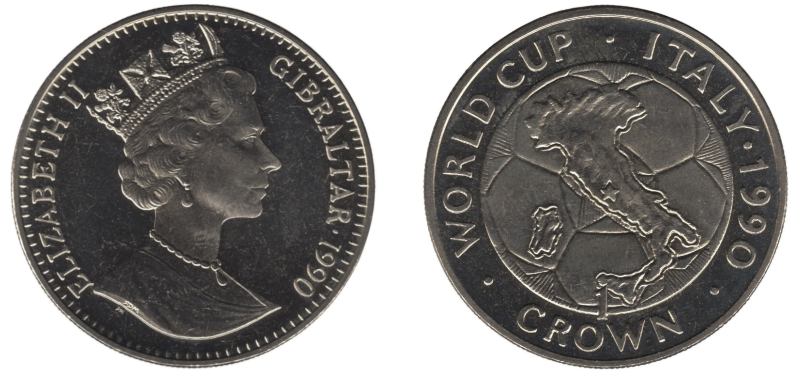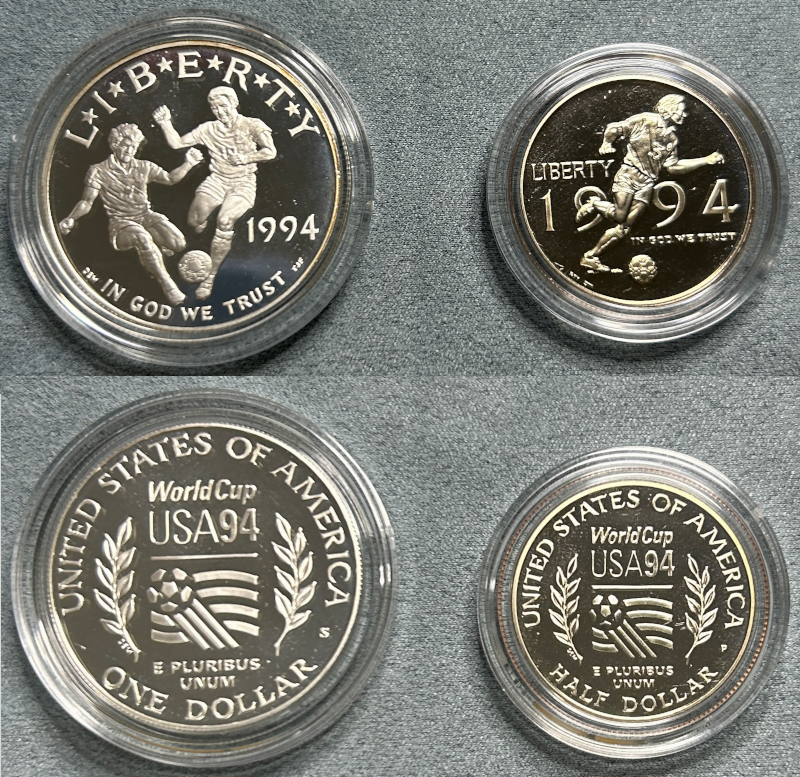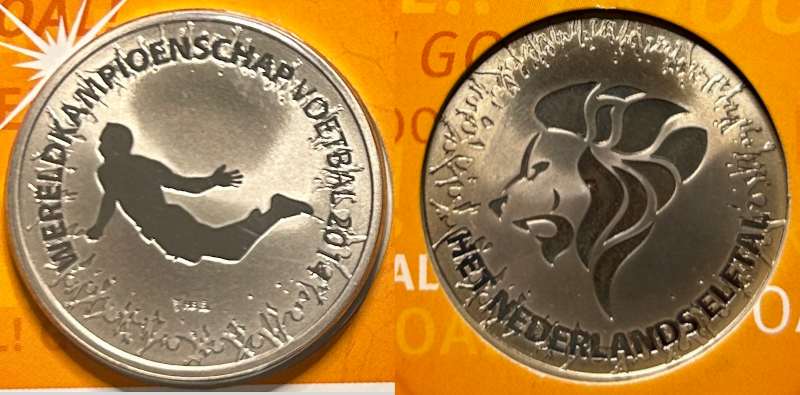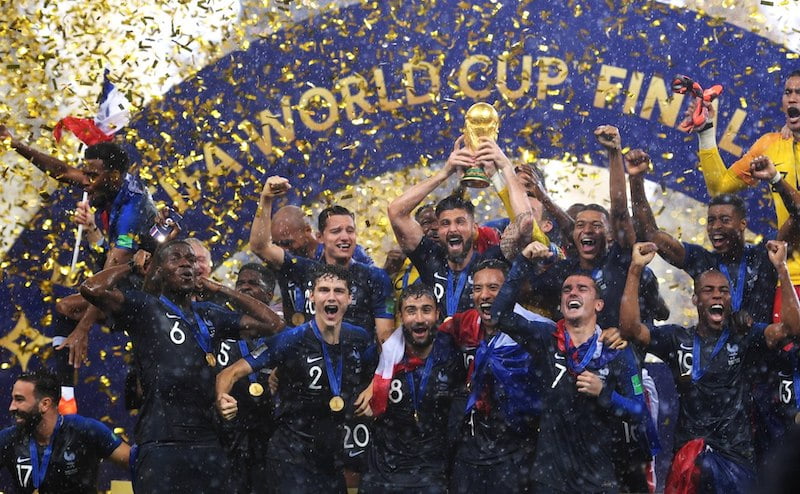The upcoming FIFA World Cup will make history in several ways.
It will be the first tournament to take place in November-December, disrupting the European club season.
It will also be the first World Cup to take place in the Middle East, and the first to take place in an Arabic country.
One thing that won’t be a break with precedent? There will be plenty of coins issued to commemorate the event. FIFA, the Central Bank of Qatar, and various countries have already made some available for sale and there are probably a lot more out there.
I’ve acquired a few World Cup coins over the years. Read all about them below:
1990 FIFA World Cup: Italy

The 1990 World Cup was notable for a number of reasons.
There was Diego Maradona eliminating the favored Italians on their home soil and being viciously booed by the fans at Napoli’s Stadio San Paolo — a stadium that would one day be renamed in his honor.
There was Cameroon pulling off a shocking upset of Maradona’s Argentina in the group stage, a win that resulted in generations of future fans picking them as their Cinderella team at subsequent World Cups (their best result since 1990: finishing 20th at the 2002 World Cup).
There was a fairly unheralded West Germany team that won it all despite being distracted by the ongoing reunification process (obligatory plug for my undergrad honors thesis).
One thing there wasn’t? Offense. The 1990 World Cup saw an average of 2.21 goals per game, a record-low that has yet to be surpassed, and 16 red cards, a mark that stood until 2010. The four penalty shootouts was also a record that has, since, been matched by the 2006, 2014 and 2018 tournaments. The negative tactics led to some rule changes, including the back-pass rule, that helped the game tremendously.
The tournament was also notable for England’s breakthrough performance. While they went into the tournament as one of the favorites, the World Cup came during a dark time in England’s footballing history. Racism and hooliganism were rife while the trauma of the Heysel and Hillsborough disasters was still fresh on people’s minds. The post-Heysel ban on English teams playing in Europe hurt the Football League, as many top domestic players headed to teams abroad. Attendance at league matches declined and the Football League’s standards and revenues fell behind their competitors in Spain and Italy.
England’s run to the semifinals caused the country to rediscover its love for the game, helping set the stage for the formation of the Premier League in 1992. Nowadays, it’s the richest and most-watched league in the world.
But let’s be honest. The real legacy of Italy ‘90 for England is “World In Motion.” Performed by New Order and several members of the English National Team, the song was a huge upgrade over the usual World Cup single in that it featured a big-time, well respected band and lyrics that could apply to both football and everyday life. It’s a catchy song that was so popular that it remains New Order’s only #1 single in the U.K.
But the pièce de résistance is a memorable rap by Liverpool winger John Barnes. It’s a bona fide pop cultural phenomenon, having been adapted into commercials, a social media challenge and even a parliamentary speech. It might be an exaggeration to call it the greatest guest spot in music history, but it’s certainly up there with the likes of Eric Clapton playing the solo on “While My Guitar Gently Weeps,” Flea playing the bassline on “Bust a Move” or Michael Jackson singing the hook in “Somebody’s Watching Me.”
Ok. Maybe not. But Barnes does acquit himself reasonably compared to other footballers-turned-rappers. And certainly more people know this song than another World Cup rap song that came out in the U.S.A. at around the same time (“Victory” by Def Jef and DJ Eric Vaughn). “World in Motion” continues to show up on lists of the greatest World Cup songs of all time and is one of the reasons why people in England have fond memories of Italia ‘90 even though the team ended up losing in the consolation match to the host country.
It’s certainly not because the English public fell in love with the commemorative coins issued by the London Mint. Perhaps due to football’s low standing in the country and the time, souvenir crown coins were issued in the English territories of Gibraltar, the Cook Islands and the Isle of Man, but not the home country.
In fact, looking at the Royal Mint website, there haven’t been a lot of World Cup or European Championship coins released in the U.K. There were plenty of coins issued in advance of the London Olympics (including ones marking three years, two years, and one year until the opening ceremony). There was one for the Rugby World Cup in Wales in 1999 and a re-release of a 2017 Lion coin to celebrate England’s fourth place finish at the 2018 World Cup.
But that’s about it. So maybe the trick is that England has to either host the World Cup or win it in order to get a coin issued by the Royal Mint. Or they could always issue a coin to commemorate “World in Motion.” As a wise man once said: “You’ve got to hold and give/ But do it at the right time.”
1994 FIFA World Cup: USA

USA 1994 was a rousing success in many ways. The tournament made a ton of money and remains one of the most profitable World Cups in history. It was the most attended World Cup ever with an average of nearly 70,000 fans per match. The success of the tournament helped lead to the creation of MLS and boosted the long-term competitiveness of the U.S. men’s national team.
The tournament gave us one last glimpse of Maradona, who shrugged off years of substance abuse and weight issues and showed up slim and cut and was one of the best players in the world during the first two matches of the group stage. Of course, because there are no fairy tales in this world, he predictably failed a drug test and got thrown out of the World Cup and never played a competitive match for Argentina again.
We also saw a brilliant performance by the underrated Romario, who shone as he led Brazil to its fourth World Cup title. Always less heralded than the likes of Pele, Zico, Garrincha and his successors, Ronaldo, Rivaldo and Ronaldinho, Romario finally got his due as he was recognized as one of the best players in the world and deservedly won the Golden Ball as the tournament’s best player.
It wasn’t all great, though. The tournament also resulted in the stunning murder of Colombian defender Andres Escobar, who was executed gangland style back in his home country after his own-goal against the U.S. helped eliminate his team. It remains a shocking and horrific moment in football history and one that cast a dark shadow over the sport in Colombia that lasted for decades.
The above coins were issued by the U.S. Mint in preparation for the 1994 tournament. In addition to a silver dollar and half dollar, the Mint also struck a gold $5 coin, which, obviously, costs quite a bit on the market today. The silver coins, on the other hand, are quite affordable — a two-coin set with the original box and papers goes for about $40 on eBay.
There’s an interesting bit in the legislative history behind the bill authorizing the World Cup coins (the law also provided for White House, Christopher Columbus Quincentenary, and James Madison/Bill of Rights commemorative coins, and a silver medal for Gulf War veterans). Senators Alan Cranston (D-CA), Malcom Wallop (R-WY), Ted Kennedy (D-MA) and Orrin Hatch (R-UT) got an amendment passed in the Senate version of the bill that would have authorized the Mint to modernize the designs of our existing circulating coinage. Additionally, the first coin the Mint chose to redesign had to bear an image on the reverse commemorating the bicentennial of the ratification of the Bill of Rights. Subsequent coins could bear similar Bill of Rights-related designs, according to the amendment.
“The 1975-76 Bicentennial reverses of the quarter, half dollar, and dollar minted in celebration of the 200th anniversary of our Nation’s independence were very favorably received by the public and raised substantial profit for the Treasury,” Cranston said on the Senate floor on November 27, 1991. “The Nation’s 10 million coin collectors insure that coin design change will produce huge profits.”
The Senate bill with the amendment ultimately got rejected by the House and was removed from the final bill during conference (Cranston and Kennedy voted against the final bill while their GOP co-sponsors voted for it). As such, we didn’t get the Bill of Rights-inspired design on our circulating coins, nor did we get any kind of modernized re-design — at least not until the end of the decade.
2014 FIFA World Cup: Brazil

On the flip side, the 2014 World Cup in Brazil was a disaster for the host country. Costing an estimated $13.5 billion, the tournament exacted a tremendous toll on Brazil’s infrastructure and had very little impact on its economy. It also diverted much needed funds away from important, necessary projects so that the country could focus on the immediate task of building and renovating stadiums and hotels. According to the BBC, 170,000 Brazilians lost their homes in order to accommodate the various World Cup-related construction projects.
It was also a disaster for Brazil on the pitch. Despite coming into the tournament as the favorites, Brazil got waxed by Germany in the semifinals, losing 7-1 in what is still their worst World Cup defeat of all time. The result was so bad and traumatic that several Brazilian players offered public apologies while manager Luiz Felipe Scolari, the man at the helm for the country’s 2002 World Cup victory, called it the “worst day of my life” and resigned immediately after the tournament.
Things got worse for Brazil in the third-place match, as they lost 3-0 to the Netherlands. Coming off a runner-up finish in 2010, the Dutch were clearly running on fumes at that point behind their aging trio of superstars, Robin van Persie, Arjen Robben and Wesley Sneijder. Nevertheless, they had too much for Brazil and easily defeated them, giving Louis van Gaal, their Manchester United bound manager, a nice little going-away present.
The above coin was issued by the Dutch Royal Mint after the team made the semifinals and immediately sold out. The obverse image comes from the Oranje’s comprehensive 5-1 opening group stage victory over Spain, the team that beat them in the final four years prior. Spain actually went up 1-0 but then Dutch player Daley Blind sent a long pass into the box for van Persie. The forward got behind Gerard Pique and Sergio Ramos and improvised a beautiful swan-dive flying header past Iker Casillas to tie it up at 1.
The goal seemed to demoralize the Spanish and galvanize the Dutch. The Netherlands scored four more goals to win 5-1, signaling the end of Spain’s dynasty.
The goal also gave hope to Manchester United fans that van Gaal and van Persie (and Blind, who joined the team a month later) might be the right combination for us to get back to title contention. Well, we know how that turned out…

